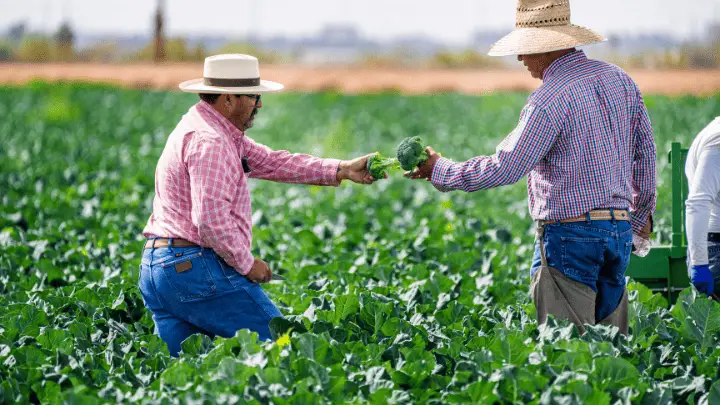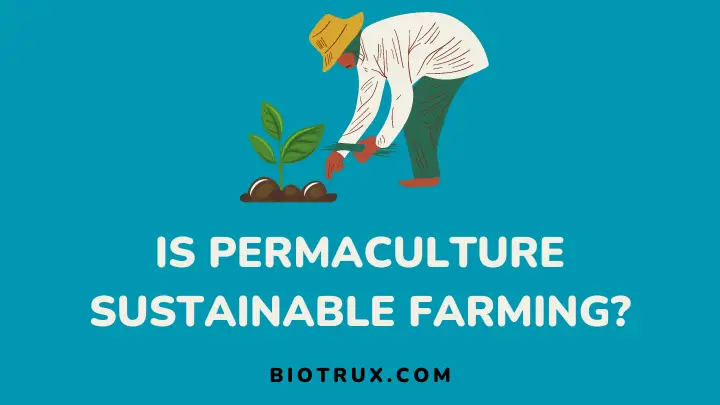Are you tired of hearing about unsustainable farming practices that harm the environment and our communities? It’s time to shift our focus to permaculture. Permaculture is a sustainable farming practice emphasizing working with nature rather than against it.
Permaculture practices such as crop rotation, companion planting, and natural pest control can produce abundant crops while protecting the environment. But what makes permaculture truly unique is its emphasis on community involvement.
This approach fosters a sense of responsibility and connection to the land and each other. In this article, you will explore why permaculture is a more sustainable form of farming, its best practices, and how it relates to sustainable farming.
Join me on this journey towards a healthier planet and stronger communities through permaculture.
What is Permaculture?
Permaculture is a design philosophy and methodology that emphasizes sustainability and ecological harmony. It involves using nature as a model and its natural systems to create self-sustaining agricultural and human environments.
Permaculture principles focus on reducing waste, creating renewable energy sources, and maintaining healthy soil and ecosystems. These principles can be applied to everything from home gardening to community planning and help promote environmental sustainability and resilience.
It is a holistic approach to farming, gardening, and community development that aims to reduce the impact of humans on the environment and promote self-sufficiency. By following permaculture practices, we can work towards a more sustainable and equitable future for all.
The Importance of Sustainable Farming in Today’s World
As the world population grows, food and agricultural products demand increases. However, this demand must be met sustainably for the environment and future generations.
Sustainable farming practices prioritize the long-term health and well-being of the land, the farmers, and the consumers. This means reducing the use of harmful chemicals, preserving biodiversity, conserving water resources, and minimizing waste.
By using techniques such as crop rotation, natural fertilizers, and integrated pest management, farmers can increase yields while also preserving soil health and biodiversity. By adopting sustainable farming practices, we can protect the environment, improve food quality, and create a more equitable and just agricultural system.
As consumers, we can support sustainable farming practices by buying locally-grown produce, choosing organic options, and supporting sustainable agriculture initiatives.
Relationship Between Permaculture and Sustainable Farming
Permaculture is a holistic approach to farming that focuses on creating a self-sustaining ecosystem. It emphasizes using natural fertilizers, companion planting, and soil conservation.
On the other hand, sustainable farming is a more general term that refers to farming practices that preserve natural resources and avoid environmental harm.
Permaculture is a type of sustainable farming that promotes a healthy relationship between the environment and the food we consume. It is an essential aspect of creating a sustainable future for agriculture.
Reasons Why Permaculture is Sustainable Farming
1. Community engagement and empowerment
Through permaculture, communities can take control of their food production, reducing their reliance on external food sources and strengthening their sense of self-sufficiency.
Permaculture also encourages sharing knowledge and resources within a community, creating a supportive network that can help ensure the long-term success of sustainable agriculture practices.
Permaculture fosters a connection to the land and environmental stewardship. It empowers local communities to take charge of their resources and food systems.
2. Economic viability and long-term sustainability
Permaculture is a sustainable farming practice that promotes economic viability and long-term sustainability.
Unlike conventional farming methods that deplete soil and resources, permaculture utilizes techniques focusing on building healthy soil, preserving biodiversity, and reducing waste.
By implementing systems that mimic nature, permaculture farmers can achieve sustainable yields that support their economic livelihoods without compromising the environment.
Additionally, permaculture practices can be maintained over the long term, ensuring that the land and surrounding ecosystems remain healthy and productive for future generations.
3. Potential to address food insecurity and poverty
One of the reasons why permaculture is gaining popularity is because it has the potential to address food insecurity and poverty. Permaculture farms can produce healthy and affordable food for local communities by creating a system that utilizes local resources.
This reduces their dependence on expensive imports. Additionally, permaculture farms can provide employment opportunities and support local economies, contributing to poverty reduction efforts.
Overall, permaculture is a promising approach to sustainable agriculture that can help create more resilient and equitable food systems.
4. Promotion of biodiversity
Permaculture promotes biodiversity, which is crucial for sustainable farming practices. Permaculture farms support various plants, animals, and microorganisms by creating diverse and interconnected ecosystems.
This biodiversity helps maintain the farm’s health and balance, making it more resilient to pests, diseases, and climate fluctuations. Additionally, a diverse farm can provide various products and services, such as pollination and pest control.
This reduces the need for harmful chemicals and promotes natural ecosystem functions. Promoting biodiversity in permaculture farming promotes a more sustainable and resilient agricultural system.
5. Water conservation management
One major reason permaculture is sustainable farming is because it prioritizes water conservation and management. Permaculture techniques like rainwater harvesting, swales, and contouring help to retain and manage water more efficiently, minimizing water wastage.
This is important because water is a finite resource and traditional farming practices often lead to overuse and depletion of water sources. By incorporating water-saving techniques, permaculture allows farms to thrive even during dry spells and helps ensure our water resources’ sustainability.
6. Reduces waste and pollution
Using organic materials and natural techniques, permaculture farmers create a closed-loop system that minimizes waste produced and maximizes the use of resources. This reduces pollution and helps conserve resources, making farming more sustainable.
Permaculture also promotes the use of renewable energy sources such as solar or wind power, further reducing the carbon footprint of farming. Farmers can help protect the environment by adopting permaculture practices and ensuring a sustainable future for generations.
7. Promotes green products
By promoting green products, permaculture minimizes harmful chemicals and fertilizers often used in conventional farming practices.
This benefits the environment and ensures our food is healthy and free from harmful substances. In short, permaculture is sustainable farming that prioritizes using green products.
8. Regenerative soil health
Permaculture focuses on regenerative soil health, which means improving and maintaining the health of the soil through natural processes. This leads to increased fertility and resilience, habitat restoration, and reduced need for artificial fertilizers and pesticides.
Regenerative soil health also helps to retain water, reducing the need for irrigation and combating soil erosion. By focusing on the health of the soil, permaculture promotes sustainable and long-lasting agricultural practices that benefit both the environment and farmers.
9. Natural pest control
Instead of relying on harmful chemicals, permaculture promotes attracting beneficial insects, planting companion crops, and creating diverse habitats. By doing so, permaculture reduces the need for harmful pesticides, making the ecosystem healthier for everyone involved.
Natural pest control is just one-way permaculture promotes sustainable farming practices that are better for both the environment and the people who consume the crops.
10. Low-input farming
One of the reasons why permaculture is a sustainable form of farming is because it utilizes low-input farming methods.
The focus is on creating self-sufficient ecosystems that support crops and animals rather than on external inputs like pesticides, fertilizers, and energy. By reducing the need for these external inputs, permaculture helps to reduce environmental damage and promote healthier ecosystems.
Additionally, because permaculture is focused on creating sustainable systems, it often leads to lower long-term costs and greater resilience in environmental challenges like drought.
Best Practices for Implementing Permaculture

Implementing permaculture practices in your garden or land can help create a sustainable and resilient ecosystem. Here are five best practices to consider:
1. Design with nature
Observe your site’s natural patterns and processes before implementing any changes. Use this knowledge to mimic nature’s patterns to design your garden or land. This includes incorporating diverse plant species, using natural water retention techniques, and creating wildlife habitats.
2. Use organic and regenerative methods
Avoid synthetic pesticides and fertilizers, which can harm the soil and beneficial organisms. Instead, opt for organic and regenerative methods like composting, crop rotation, and cover cropping to nourish the soil, enhance biodiversity, and promote a healthy ecosystem.
3. Maximize energy efficiency
Reduce reliance on external energy sources by designing your permaculture system to maximize energy efficiency. Using passive solar design, installing renewable energy systems, such as solar panels or wind turbines, and minimizing energy consumption can all help.
4. Practice water conservation
Implement water conservation techniques like rainwater harvesting, greywater recycling, and drip irrigation. These practices can help minimize water waste and ensure your garden or land remains resilient during drought.
5. Foster community collaboration
Permaculture is not just about gardening; it’s also about building resilient communities. Foster a sense of community by collaborating with neighbors, participating in community gardens, and sharing your knowledge and experiences.
Following these best practices can create a productive and sustainable permaculture system that benefits you and contributes to a healthier planet. Start small, learn as you go, and remember that every small step counts towards a more sustainable future.
FAQs
How is permaculture different from conventional farming methods?
Conventional farming frequently depends on monoculture and chemical inputs, while permaculture prioritizes ecological harmony, sustainability, and biodiversity.
Can permaculture be practiced on a large scale?
Yes. Permaculture principles can be implemented in large-scale agricultural systems to promote sustainable and regenerative practices.
Is permaculture only for rural areas, or can it be used in urban settings?
Permaculture can be adapted for urban environments with practices like rooftop gardens and community food forests.
How does permaculture contribute to climate change mitigation?
Permaculture’s focus on soil health and biodiversity aids in sequestering carbon and reducing greenhouse gas emissions.
Can permaculture be economically viable for farmers?
Permaculture’s emphasis on self-reliance and local markets can enhance the economic viability of farming.
Are there any famous examples of successful permaculture projects?
Several permaculture projects worldwide, such as Zaytuna Farm in Australia, have demonstrated successful implementation.
Final Thoughts
After discussing the major reasons, best practices, and relationships with sustainable farming, it is safe to say that permaculture is indeed a sustainable farming method. By following permaculture principles, farmers can create a self-sustaining ecosystem that can provide for their needs while being environmentally friendly.
Permaculture emphasizes the importance of working with nature rather than against it, promoting biodiversity and natural resource conservation. Using organic and natural methods in permaculture also ensures that the soil remains healthy and productive for years.
While permaculture may not be a perfect solution, it is a step in the right direction toward creating sustainable agriculture. With the world facing increasing environmental challenges, permaculture farming provides a viable alternative that can help us create a more sustainable future.
You can also learn how about how urbanization affects agriculture.
Thanks for reading.

